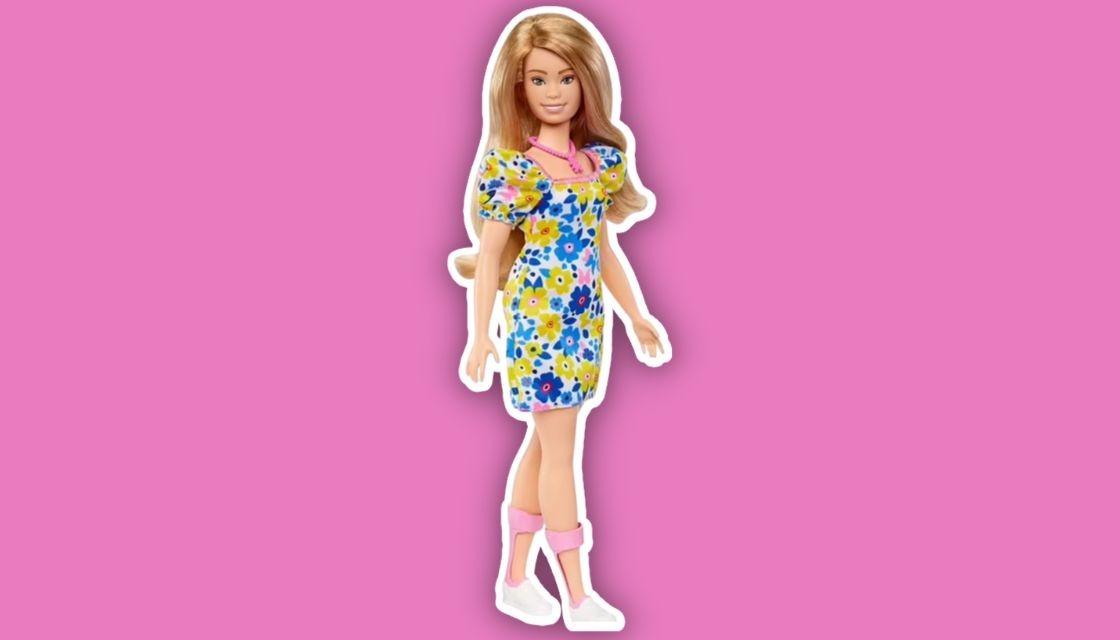
Mattel has released its first-ever Barbie with Down's syndrome in a bid to further diversify its dolls and represent more children around the world.
The newest addition to the Barbie world became available for pre-order in the UK on Tuesday, unveiled as part of the brand's inclusive Fashionistas collection.
The toy manufacturer collaborated with the National Down Syndrome Society (NDSS) to design the doll, ensuring it was an authentic representation of women living with the condition.
According to reports, the doll has been designed with a shorter frame, longer torso and features typically associated with the condition, such as a larger, rounder face, almond-shaped eyes, smaller ears and a flat nasal bridge. Other thoughtful details include the palms featuring one single line, a characteristic that can be associated with Down's syndrome.
Images released of the doll also show the attention to detail regarding its outfit. The designers opted for a butterfly-printed dress in pink, blue and yellow - the latter two colours being associated with Down's syndrome awareness - and a pink necklace featuring three upward chevrons, representing the three copies of the 21st chromosome. The chevrons, which look like small arrows, are a symbol of 'The Lucky Few', representing people who live with the condition.
To match her necklace, the doll also sports pink ankle-foot orthoses (AFOs), which can be worn by people living with the condition. AFOs are used to improve walking patterns by reducing, preventing or limiting the movement of the lower leg and foot and by supporting weak muscles, as well as maintaining joint alignment and accommodating any deformities.
To ensure the Barbie is as true to life as possible, the designers opted to include the AFOs as an emblematic accessory, despite not being worn by all people with Down's syndrome.

The release of the latest addition to the Barbie lineup has been met with positive responses, with British model Ellie Goldstein - who lives with Down's syndrome and modelled for the doll's campaign - applauding its arrival.
The 21-year-old, who has worked with the likes of Gucci and Adidas, said she was "overwhelmed" with joy when she saw the toy ahead of its release.
"I am so happy there is a Barbie with Down's syndrome. Seeing the doll, I felt so overwhelmed - it meant a lot to me and I'm so honoured and proud that Barbie chose me to show the doll to the world," Goldstein, who is one of British Vogue's cover stars this May, said in a statement.
"Diversity is important to me as people need to see more people like me out there in the world and not be hidden away."
Kandi Pickard, the president and CEO of the NDSS, said it was an "honour" to collaborate on the doll's design.
"This means so much for our community, who for the first time, can play with a Barbie doll that looks like them," she said in a statement. "This Barbie serves as a reminder that we should never underestimate the power of representation. It is a huge step forward for inclusion and a moment that we are celebrating."
As reported by the Daily Mail, the UK Down's Syndrome Association has also applauded the inclusion of the doll, with chief executive Carol Boys noting she often hears that children with the condition feel underrepresented in mainstream media.
"We welcome the fact that children in our community will be able to play with a doll that represents them and their lives. We look forward to seeing her on the shelves alongside Barbies who wear hearing aids, use wheelchairs, and celebrate inclusion."
In a statement, Lisa McKnight, Mattel's executive vice president and global head of Barbie & Dolls, said it's hoped the doll will help to counter social stigmas through play.
"Our goal is to enable all children to see themselves in Barbie, while also encouraging children to play with dolls who do not look like themselves," she said. "Doll play outside of a child's own lived experience can teach understanding and build a greater sense of empathy, leading to a more accepting world."
The Fashionista collection also includes a Barbie with braces and a Ken with a prosthetic leg.



